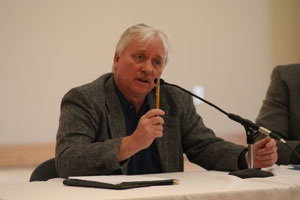Commission could be valuable to CEU
Dale Evans, head of the College of Eastern Utah’s Mining Department and veteran miner, gave a stunning presentation to the Utah Mine Safety Commission Oct. 2 showing the definite need for funding in order to create more realistic and effective training programs.

This archived article was written by: Kris Kohler
Dale Evans, head of the College of Eastern Utah’s Mining Department and veteran miner, gave a stunning presentation to the Utah Mine Safety Commission Oct. 2 showing the definite need for funding in order to create more realistic and effective training programs.
“We trained 1,860 miners last year,” said Evans. “And we did it with four full-time and two part-time instructors. The Mining Safety and Health Administration’s state grant program is meant to subsidize a program, not to support it and right now that grant coupled with tuition is the base for our program. We are opening the door for inadequate training to take place.”
Experts fear that if we don’t do something about the lack of effective education and training in the energy field fast, that it will be very difficult to prevent future disasters caused by a lack of experience due to the upcoming retirement of a vast number of veteran mine workers. The ratio of experienced to unexperienced miners is one of the industries top concerns, he said.
“In 1980 the program was given $6 million for 36 states and last year the program was allocated $8.2 million for 49 states, the Navajo Nation and Puerto Rico,” said Evans. “Each year our piece of the pie gets a little smaller.”
Evans made several recommendations on how CEU could further enhance the quality of training.
The first issue that was addressed was the difference in training standards in Utah compared with those in West Virginia. Utah requires new miners to sit through a 32 hour class and then complete an eight-hour site specific course in order to be considered qualified to go to work.
West Virginia requires an 80 hour course and then a state exam. After comparing the requirements for both states, Evans made it clear that Utah’s initial training requirements are insufficient.
Evans recommended that Utah offer apprenticeship programs to improve the quality and experience of our miners and to also require yearly recertification’s along with a more interactive, redesigned annual refresher. Evans said that the current refresher is no where near as effective as it could be.
“It doesn’t hurt for all of us to learn new things,” said Evans, “We also need to make sure miners, fire bosses and safety foremen are current with all new regulations.”
According to local coal mine officials miners are moving into positions of great responsibility as soon as they get certified due to the constant need for leadership. A lot of the time people are given a leadership position because they are certified and not because they have the necessary experience needed to do the job.
“Coal mining is definitely not something that you can learn in a classroom,” said Steve Burge, head of the Western Energy Training Center.
Throughout the presentation Evans underlying goal was to uncover the need for funding for the the expansion and development of more effective training programs including the proposed underground mine simulation, that, if funded, will provide a realistic way to train miners in a safe and controlled environment.
Community and school officials are hopeful that some good will come out of the Crandall Canyon mine disaster.
“I have seen a lot of disasters in my time, and we learn something from each of them,” said Burge, “but I feel that the Utah Mine Safety Commission will ultimately help make mining a safer industry, and thats what counts.




